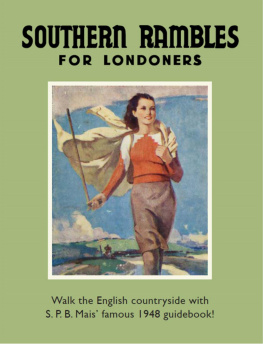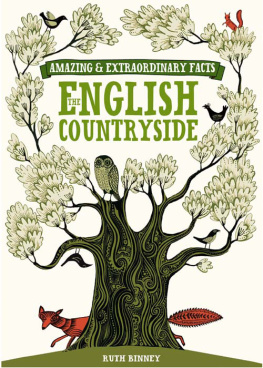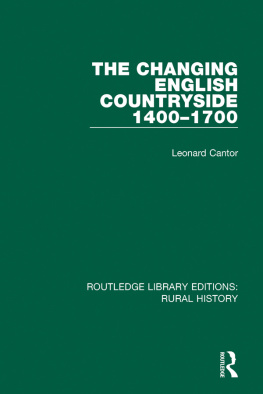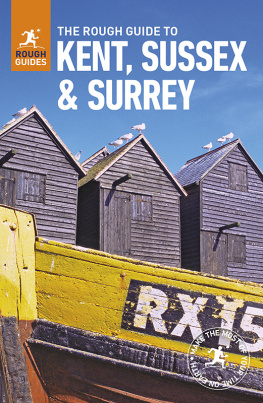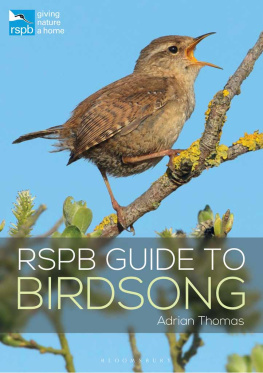SOUTHERN RAMBLES
FOR LONDONERS
By
S. P. B. MAIS, M . A .
LONDON, 1948
CONTENTS
MAPS, ETC.
General Area of Rambles
Railway Map
Map diagrams are also shown at commencement of each Ramble
THE HANDY ELECTRIC TRAIN : FREQUENT SERVICES AT REGULAR INTERVALS TO RAMBLELAND STATIONS OF SURREY AND SUSSEX
(Above shows a LondonRedhillBrighton train)
PREFACE
A S I said when I originally set out, the object of this book is quite simple. It is to help you to indulge a very natural instinct, to obey a natural law. We are, like it or not, children of the earth, and to quote Professor G. M. Trevelyan, removed from her our spirit withers or runs to various forms of insanity. We just have to get back to the country whence we were originally sprung or wilt away both in spirit and body. Unless we can refresh ourselves at least by intermittent contact with nature we grow awry.
My object was (and is) to show you how most easily to get back and where you are most likely to find quietude and loveliness. The face of England has lately undergone and is still undergoing a very rapid change.
The War has left its sears on the countryside no less than on the towns. Once familiar landmarks have disappeared and, what is far worse from the walkers point of view, footpaths have been obliterated by the farmers and vast sections of common land seized by the War Department and churned into impassable morasses by tanks and other engines of war.
This is not the place to discuss whether these are the unavoidable penalties of progress and civilisation. My job is done when I pass on certain warnings. In this modern version of the Pilgrims Progress I merely put up signposts. Here is the Slough of Despond. Keep out or Here is Doubting Meadow. Here lie giants. Beware.
The old Southern Rambles would have been completely out-of-date even if there had been no war, for the simple reason that Londons middle-aged spread is increasing. It is no use lamenting the fact that St. Mary Cray and Foots Cray were lovely country villages when I was a boy. The fact has to be faced that they are no longer country villages.
You must realise that if you want real country walks you must accept the fact that the North Downs are now roughly Londons outer bastion.
There are plenty of unexpectedly rich walks inside the bastion, but you never know when you walk out of a wood that you wont find yourself faced with a new satellite town or housing estate, so for the sort of walk I have in mind you ought not to leave the train till you get as far west as Guildford or as far south as Dorking, Redhill or Sevenoaks.
It so happens that the train services to the ideal starting-points are fast and frequent, so you wont have to spend more time in the train than you would have in going half the distance in the old days.
What has surprised me (and I am supposed to know my England) is the wealth of country that still remains unexplored within twenty-five miles of Charing Cross and Victoria.
The farmers may not have redeemed their promises to reopen the public footpaths and bridle-tracks that they were allowed to plough up during the War. The War Department have certainly aroused the resentment of all country lovers for their high-handed action in earmarking the best walking country for their training areas(Ockley Common and Chobham Ridges have to be seen to be believed)but on the credit side no praise could be too high for the foresight of the Surrey County Council in preserving and signposting tens of thousands of acres of woodland, downland and commons in the Dorking area where you may wander at will and most certainly as easily get lost as if you were in the Northern Highlands or in the wilds of Central Wales.
Indeed so rich and profitable is the Dorking area that I have spent the greater part of a year in that one corner of Surrey tracing new (to me) tracks, each one lovelier and more sequestered than the one before.
I have changed my tactics. I am becoming more selective and learning wisdom. When I originally set out I fell into the trap of imagining the success of a walk to depend on its distance.
As an undergraduate I was never satisfied unless I covered about 35 miles a day. On my original Southern Rambles I set myself what politicians so oddly call a target of fifteen to twenty miles. It is only now that I have learned that a maximum of enjoyment can be got out of a walk of from eight to twelve miles. This allows of loitering to listen to birds singing, watching birds fly, picking and eating hazel-nuts, chestnuts, whortleberries, wild strawberries, blackberries, and so on, according to the season of the year, lying on thyme-scented downs and just gazing up into the blue or watching the clouds scurry by.
Best of all this allows of a margin of time in which to be genial in the bars of tiny village inns, to listen to the philosophy of a road-mender or shepherd and the problems of the farmer who is as ready to welcome the rambler who takes a knowledgeable interest in his beasts or crops as he is to set the dog on the ill-mannered or thoughtless stranger who breaks down his hedges or leaves his field gates open for the sheep to stray.
It is most important to remember that even if you fought against Germany to keep your England free, the right cultivation of the land lies in the hands of the farmers to whom you have entrusted it. You have no more right to trespass over his fields at random than you have to ride a horse over your neighbours lawn or a bicycle up and down his garden path.
There are vast sections of Surrey and Kent that to our eternal advantage have been acquired for us and presented to us by the National Trust, a body that we owe it to ourselves and our children to support.
All over these counties you will find unobtrusive notices, the sign of the oak leaf, to denote the fact that you are now on your own land and have an owners right to walk where you will. To select almost at random, Hind-head, Witley Common, Hydons Ball, Albury Heath, Leith Hill, Hackhurst Downs, Bookham Common, Box Hill, Colley Hill, Crockham Hill, Toys Hill, Ide Hill, Finchampstead Ridges, Selborne Hill, South Hawke... all these and hundreds more places of exceptional loveliness are earmarked and preserved for your enjoyment in perpetuity. It is, of course, all too little, only a hundred thousand acres to set against the million acres seized by the War Department, and thirty-three million acres cultivated by the farmer. But it is something to be thankful for as you stand on one of these many Southern heights with all the wealth of the dim blue goodness of the weald stretching away below you towards the sea. It is something to know that this at any rate is not to be built over or (we hope) annexed as a military training area.
In my original tour I was so anxious to cover a large territory that I didnt mind a few miles of road walking.
The roads have become even more dangerous for the footslogger, and they have certainly become more unpleasant. My object this time has been to avoid roads altogether.
I have, of course, not always been successful in this, but you will find very little road-walking on any of these routes, as you will see by glancing at the maps.
The best plan, if the walk proper begins a mile or two outside Dorking, Guildford or any other town, is to take a bus as far as a stile or lane-end, and set your face resolutely against any road walking at all. Trudging along a road only ruffles the spirit instead of soothing it.

